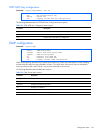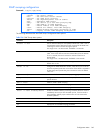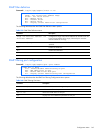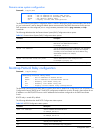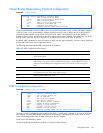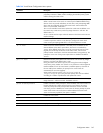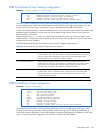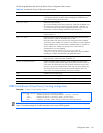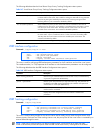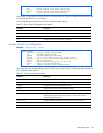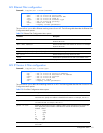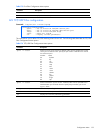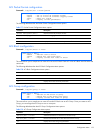
Configuration Menu 146
VRRP Virtual Router Priority Tracking configuration
Command: /cfg/l3/vrrp/vr <1-255>/track
[VRRP Virtual Router 1 Priority Tracking Menu]
vrs - Enable/disable tracking master virtual routers
ifs - Enable/disable tracking other interfaces
ports - Enable/disable tracking VLAN switch ports
cur - Display current VRRP virtual router configuration
This menu is used for modifying the priority system used when electing the master router from a pool of virtual routers.
Various tracking criteria can be used to bias the election results. Each time one of the tracking criteria is met, the
priority level for the virtual router is increased by an amount defined through the VRRP Tracking Menu.
Criteria are tracked dynamically, continuously updating virtual router priority levels when enabled. If the virtual router
preemption option is enabled, this virtual router can assume master routing authority when its priority level rises
above that of the current master.
Some tracking criteria (vrs, ifs, and ports below) apply to standard virtual routers, otherwise called “virtual
interface routers”. A virtual server router is defined as any virtual router whose IP address (addr) is the same as any
configured virtual server IP address.
The following table describes the Virtual Router Priority Tracking Configuration Menu options.
Table 165 Virtual Router Priority Tracking Configuration Menu options
Command Description
vrs disable|enable When enabled, the priority for this virtual router will be increased for each virtual router
in master mode on this switch. This is useful for making sure that traffic for any particular
client/server pairing are handled by the same switch, increasing routing and load
balancing efficiency. This command is disabled by default.
ifs disable|enable When enabled, the priority for this virtual router will be increased for each other IP
interface active on this switch. An IP interface is considered active when there is at least
one active port on the same VLAN. This helps elect the virtual routers with the most
available routes as the master. This command is disabled by default.
ports disable|enable When enabled, the priority for this virtual router will be increased for each active port on
the same VLAN. A port is considered “active” if it has a link and is forwarding traffic.
This helps elect the virtual routers with the most available ports as the master. This
command is disabled by default.
cur Displays the current configuration for priority tracking for this virtual router.
VRRP Virtual Router Group configuration
Command: /cfg/l3/vrrp/group
[VRRP Virtual Router Group Menu]
track - Priority Tracking Menu
vrid - Set virtual router ID
if - Set interface number
prio - Set renter priority
adver - Set advertisement interval
preem - Enable/disable preemption
ena - Enable virtual router
dis - Disable virtual router
del - Delete virtual router
cur - Display current VRRP virtual router configuration
The Virtual Router Group menu is used for associating all virtual routers into a single logical virtual router, which
forces all virtual routers on the switch to either be master or backup as a group. A virtual router is defined by its
virtual router ID and an IP address. On each VRRP-capable routing device participating in redundancy for this virtual
router, a virtual router will be configured to share the same virtual router ID and IP address.




